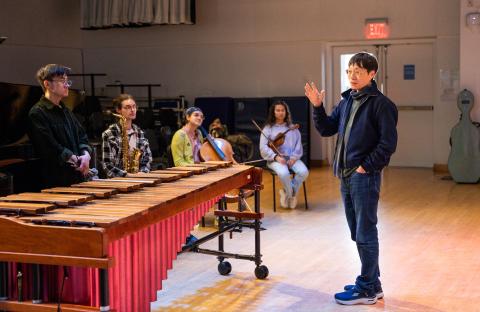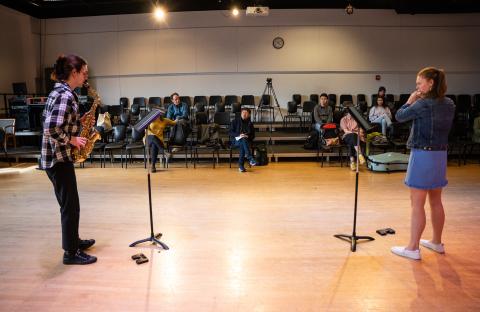Q&A with Visiting Artist Lei Liang

Boston Conservatory visiting artist Lei Liang
Bill Wadman
Creative listening is at the core of composer Lei Liang’s work. His 2018 composition A Thousand Mountains, a Million Streams imagined the sonic world of a Chinese landscape painting; and his most recent piece for orchestra, Six Seasons, stemmed from a partnership with oceanographers who captured the sounds of seasonal ice forming on the surface of the Arctic Ocean. These field recordings provide invaluable data to research scientists; but to a composer with an ear for metaphor, they are the sound of “ice being born”—and a wellspring of musical inspiration that Liang is now sharing with students at Boston Conservatory through a new venture known as Lei Lab@Berklee.
Liang is a research artist and chancellor’s distinguished professor of music at University of California San Diego, where he founded the original Lei Lab in 2023 with support from Berklee Trustee and Boston Conservatory Legacy Trustee (Snow) Dan Qin. Affiliated with the university’s Qualcomm Institute, the laboratory explores the “inevitable convergence of arts and science,” combining Liang’s compositional prowess with state-of-the-art research practices and a relentless curiosity about the natural world.
Lei Lab@Berklee will bring Liang to Boston Conservatory’s campus as a visiting artist for five consecutive academic years. He will teach private lessons and seminars with composition students, coach contemporary classical music ensembles, and cocurate the school’s annual New Music Festival. This new partnership (once again supported by Qin) also will result in two newly commissioned compositions.
During his spring 2024 residency, Liang worked with students of Associate Professor Sarah Brady (a longtime friend and frequent collaborator), workshopping two of his compositions and coaching students through improvisation exercises based on the same Arctic Ocean sounds that inspired Six Seasons. “At the heart of contemporary music is collaboration with living composers,” Brady says. “The students really felt the essence of what a collaboration can be with Lei, who treated them as creative equals and with such beautiful respect.”
Liang is a Guggenheim Fellow, a Rome Prize winner, a finalist for the Pulitzer Prize in Music, and a recipient of the prestigious Grawemeyer Award for A Thousand Mountains, A Million Streams, which was performed at Carnegie Hall in 2023 by the Boston Modern Orchestra Project, with Brady as principal flutist.
During your visit to campus, you coached Sarah Brady’s contemporary ensemble on two of your compositions. Could you tell me more about them?
One is an earlier piece that is very meaningful to me, called Lake, which is inspired by a meditation retreat that I participated in. It’s a very soulful piece that helped me to understand my relationship with sound and silence. It’s like a little mirror; I need to revisit this piece from time to time, almost like to face myself again. The idea came when I was walking around a lake in early spring. There was a V shape on the lake, and I didn’t realize what it was until I saw a beaver swimming in the water. What was so moving for me was that I understood that the lake itself is silence. When the beaver swims on it, leaving a mark—that’s a sonic signature. As a composer and a performer, that’s how you inscribe your sonic signature: on silence.
“As a composer and a performer, that’s how you inscribe your sonic signature: on silence.”
—Lei Liang
The other piece is one of my newest works, called Six Seasons. The piece came out of my collaboration with oceanographers at UC San Diego’s Scripps Institution of Oceanography. I have worked with geologists, oceanographers, engineers, and software developers to create new ways to listen and to make music in the larger context of issues that are challenging all of us across the globe. Six Seasons comes from the Inuit’s way of thinking of the calendar. There are six seasons, marked by the sounds of the changing environment—such as the footsteps of the polar bear signifying the beginning of a new season.
You were inspired by the primary importance of listening as opposed to the usual, astronomical way of marking the seasons?
Exactly. Listening is actually a very important part of the awareness that makes us understand the passing of time in nature. And, the sounds that I’m bringing with me during my visit [to Boston Conservatory] are the work of my team in collaboration with the oceanographers, which includes recordings captured by hydrophones placed 300 meters below the sea surface in the Arctic, at places completely inaccessible to humans until now. That includes a lot of ice sounds—all different kinds of ice formations and movements—and the birth of ice. We have sounds that capture the ice being born, when the open water starts to freeze in October.
That must be amazing. What does it sound like?
Oh, it’s the most beautiful sound I have ever heard. It’s incredible, and what’s important is that because of the collaborative nature of our work, we are not only interested in the sounds for sounds’ sake; we are actually inspired by the information that comes with the sound, through the eyes of oceanographers.
When you’re using field recordings to inspire musical composition, do you attempt to mimic specific sounds on the instruments—perhaps using extended technique? Or is the inspiration more thematic?
All of the above. Artists—probably just by intuition—they want to mimic, but there’s a lot more important information embedded in this. The traditional context of just listening to nature captured by a recording, that’s a very passive way of listening. Whereas when we work with a team that is highly collaborative and multimodal, we discuss things such as the air pressure, the temperature, and the mechanism that makes this sound possible. And this kind of discussion, you probably can imagine, changes the way the musicians approach their instruments.
I’m actually thinking of the project as a way of creating some kind of an instrumentation lab. You know, there are no old instruments, there are only old ways of playing. With all the instruments that Sarah Brady’s contemporary ensemble can provide us, we can actually focus on recreating playing techniques, creating a new lexicon of sounds that are in response to this rich information—a lot of this information is so relevant to our existence on the planet. It’s telling about where we came from, the state we’re in, and the danger this planet is in.
I imagine that most scientists would capture these ocean sounds, analyze the data, and think, “My job here is done.” But, you are adding another layer of experience to the process, turning the data into art. Why is that additional step so important?
You know, you put your finger on the most important word. It’s the experience. My dear colleague Dr. Joshua Jones is an oceanographer, and he has a beautiful metaphor to describe why he thinks what we do is important. Josh describes the data as tea leaves… like a cake of tea leaves that doesn’t really offer you the experience until the artist comes in to be sort of like the tea master. Of course, there’s a very laborious process to convert data into the beautiful sounds that we can now present to all of you. That’s a multi-layered process. But he said that it’s this process of restoring the beauty of those sounds to the pristine condition, and then presenting them … so that people can actually experience this artistically and creatively. That experience is very, very important.
There’s a lot of climate change–themed music out there that involves almost nothing with real research. I call it propaganda music. Other than the title, it has nothing to do with the climate. It takes a lot of collaboration and understanding and researching to learn all of this stuff so that we can really create our art in a more informed way, and hopefully a more relevant way.
Which aspects of Lei Lab’s research will you be sharing with Boston Conservatory students?
I’m bringing with me a set of harmonies that our lab developed that were created by the X-ray fluorescence analysis of earth minerals. We have a set of 188 chords, and each mineral is revealed to us by a unique harmony. It’s our latest development, and I would love to share it with the students. It doesn't make composing any easier, right? You think about Beethoven and Mozart, they probably could compose all those amazing pieces using maybe no more than 10 chords. And now we have a set of 188! That’s just the latest thing that we can bring to them, to present as an open invitation and hope some of them will engage with this new material and new technology.
You are working one-on-one with student musicians and composers, who I’m sure have been told countless times that it’s important to listen; but it seems like you are challenging them to listen much more comprehensively, in ways they may never have attempted before.
I’m a traditionally trained musician, so my background has been writing music and creating music in the concept of the concert stage, with symphony orchestras and chamber music and electronics and theater and opera. But, we’re living in 2024. Beethoven and Bach had no idea that whales could sing, for example. We can no longer afford to think that we live in the age of the three big Bs being Bach, Beethoven, and Brahms. I tend to remind the students there are incredible references—that we can also call the three big Bs—that would include beluga whales and bearded seals and bowhead whales. It’s really important because, in many ways, they’re superior musicians than we are. They sing in a range that we can’t even hear. And they sing at a speed that is beyond our brain’s capacity to process, and their songs can be hours long. So, there’s still a lot for us to catch up on.
Learn more about visiting composer Lei Liang’s creative process and his collaboration with Scripps Institution of Oceanography in this YouTube video, Hearing Seascapes.








